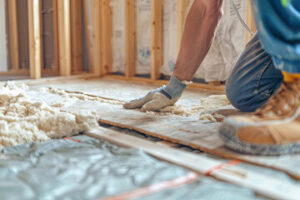Insulation Removal Perth is a critical component of improving your home’s energy efficiency and comfort. However, it is a complex process that requires expert knowledge and specialized equipment.

Safety precautions must be taken when removing attic insulation. This includes wearing a respirator to prevent inhalation of insulation fibers and dust, gloves, and protective goggles.
If you have plans to replace the insulation in your home or business, you will need to remove the old material. It can be difficult to do this on your own, so you should consider hiring a professional company for the task. The price of the project will depend on how much prep work is required to prepare the area and how damaged or infested the existing insulation is.
To prepare for insulation removal, you must wear adequate personal protective equipment (PPE). This includes gloves, goggles, a dust mask, and a coverall or disposable coverall that can be thrown away once the job is complete. This is necessary to protect yourself from asbestos, mold, or other harmful elements that could be found in the insulation. In addition, you should use a sturdy ladder or scaffolding when working in the attic and work carefully to prevent falls or accidents.
Identifying the Insulation Type is also crucial to understanding how to proceed with the removal process. Different insulation materials require specific methods of preparation and removal, so it’s important to know what type you have in your home or business. For example, fiberglass batts are typically pink or yellow and have a fluffy texture. These materials can be removed by hand, but it’s best to use a utility knife to cut them into manageable sections. Once they are cut, the sections can be removed and placed into heavy-duty plastic bags for disposal.
Foam board insulation, on the other hand, is a rigid panel that provides high thermal performance. This type of insulation may be harder to work with, but it can be removed using a utility knife or a foam saw. Again, it’s best to use a dust mask and protective gear to avoid irritation from the cutting process. Once the foam is removed, it can be disposed of according to local regulations.
Once the insulation is removed, you’ll need to clean the work area to ensure that any particles of asbestos, mold, or other contaminants are not airborne and can affect your health. This is an essential step in the removal process and must be done thoroughly to ensure a safe and healthy workplace. Additionally, you should check with your local regulations to determine how and where the old insulation will be disposed of.
Insulation removal can be a messy and dangerous process, but it doesn’t have to be. By understanding the different types of insulation, the signs of damage, proper tools, and safety guidelines, you can tackle this project with confidence. With proper planning and the right equipment, removing insulation from an attic or other spaces in your home or business is a simple and cost-effective project. To get started, contact an experienced insulation contractor to discuss your project.
Removal
Insulation removal is an essential step in home improvement projects and can provide a variety of benefits. Replacing old insulation with new, higher R-value material helps regulate temperature and reduce energy bills. It also improves indoor air quality by reducing dust and other contaminants that can cause asthma and allergies. Insulation removal also offers opportunities to seal ceiling penetrations and other areas of the house that allow air leakage.
In addition to lowering heating and cooling costs, new insulation can improve comfort by preventing unwanted drafts in the winter and minimizing hot spots in the summer. It can also help with sound reduction and vibration control. Lastly, installing insulation can increase the resale value of a home and attract eco-conscious buyers who appreciate energy upgrades.
If the existing insulation has lost its ability to insulate, is contaminated by mold or pests, or if it’s simply too damaged to be reused, it will need to be removed and replaced. Choosing the right tools and equipment for the job is crucial. Proper personal protective equipment (PPE) includes a respirator mask, goggles, disposable coveralls, and gloves to protect the body from irritants during the removal process. Ensuring proper ventilation and containment will also make the operation safer and faster.
Professionals have a variety of tools that are used for insulation removal, including a vacuum designed for insulation, a rake, and sealed bags to collect and transport the materials to be discarded. They also have a ladder and attic access to ensure a safe working environment.
Before starting to remove the insulation, it’s important to clear out the workspace and take a thorough inventory of the attic space. This will help determine the amount of insulation that needs to be removed, as well as the best way to approach the task. It’s also a good idea to consult local regulations regarding the disposal of insulation materials, as some may require permits or be considered hazardous waste.
Once the insulation has been removed, it must be disposed of properly to avoid contaminating the environment. Professionals will typically recycle or repurpose the material rather than sending it to a landfill. They will also ensure that any material containing asbestos is handled appropriately according to state and federal laws.
When it comes to home renovations, the removal and disposal of old insulation is a messy job that should be left to professionals. Not only does it save time and money, but it also minimizes the chances of a costly mistake that could result in health and safety hazards for the homeowner or their family. It’s also a great idea to contact a dumpster rental service to ensure the correct disposal of any unwanted or unusable materials. By doing this, you can be sure that your remodeling project is completed safely and with the highest possible resale value.
Disposal
While it may be tempting to simply throw away old insulation, doing so can have serious environmental consequences. It is recommended that homeowners check with their local governments to see if there are regulations in place regarding insulation disposal and recycling. This will help them ensure that they are disposing of the material in a safe way and contributing to the community and environment.
Depending on the type of insulation, there are several different disposal options available. For example, fiberglass can be recycled at certain facilities, while cellulose and spray foam must be disposed of at specially designated waste management sites. Homeowners should also consider hiring a professional service to handle the disposal process for them. This will ensure that the proper disposal standards are followed and can prevent any contamination of the environment or landfills.
In addition to being environmentally friendly, insulation disposal can also save homeowners money on their energy bills. Old insulation can be inefficient at regulating the temperature of a home, leading to high energy bills. When it is replaced with new, more efficient insulation, home owners can save a significant amount of money and enjoy a more comfortable home.
Insulation can be a hazardous material to dispose of properly, so it is important for homeowners to wear proper safety equipment when handling the material. This includes thick work gloves, a mask, and goggles. Additionally, homeowners should be sure to keep the area covered to prevent any particles from becoming airborne.
Homeowners who are considering removing their insulation should be aware that it may contain hazardous materials, such as asbestos or mold. These materials are not only unhealthy for homeowners to breathe, but they can be harmful to the environment as well. As such, it is always best to hire a professional demolition service to handle the clean-up and disposal of any hazardous materials found in the home.
If you are planning to renovate your home, it is a good idea to have the insulation removed before starting construction. This will ensure that any new materials are not placed over the existing insulation and that they adhere to the building code requirements. It will also allow you to make any necessary changes to the plumbing and electrical systems that might be impacted by the renovation.
It is also important to have the insulation removed if there are signs of rodent infestation or other pests. In addition to posing health risks, rodents and insects can contaminate the insulation with allergens and toxins. This can lead to reduced energy efficiency and a higher risk of health issues for the residents of the home. The removal and disposal of insulation can be a time-consuming and difficult task for homeowner’s without the proper experience or tools.



